Novel Cast and Wrought Al-3Zn-3Mg-3Cu-Zr-Y(Er) Alloys with Improved Heat Resistance
Abstract
:1. Introduction
2. Materials and Methods
2.1. Alloy Preparation
2.2. Microstructure and Phase Composition Analyses
2.3. Preparation of the Specimens for Microstructure Investigation
2.4. Heat Treatment and Rolling Processing
2.5. Thermodynamic Calculations
2.6. Mechanical Properties Measurements and Calculations
3. Results and Discussion
3.1. Thermodynamic Calculation of the Phase Composition
3.2. As-Cast Microstructure and Phase Composition
3.3. Evaluation of the Microstructure under Solution Treatment
3.4. Hardening under Aging Treatment and Mechanical Properties
3.5. Microstructure and Hardness Evaluation after Rolling and Annealing
4. Conclusions
Author Contributions
Funding
Conflicts of Interest
References
- Gerchikova, N.S.; Fridlyander, I.N.; Zaitseva, N.I.; Kirkina, N.N. Change in the structure and properties of Al-Zn-Mg alloys. Met. Sci. Heat Treat. 1972, 14, 233–236. [Google Scholar] [CrossRef]
- Zolotorevsky, V.S. Microstructure and Mechanical Properties of Cast Aluminum Alloys. Ph.D. Thesis, MISIS, Moscow, Russia, 1979. (In Russian). [Google Scholar]
- Zou, Y.; Wu, X.; Tang, S.; Zhu, Q.; Song, H.; Guo, M.; Cao, L. Investigation on microstructure and mechanical properties of Al-Zn-Mg-Cu alloys with various Zn/Mg ratios. J. Mater. Sci. Technol. 2021, 85, 106–117. [Google Scholar] [CrossRef]
- Novikov, I.I. Hot-Shortness of Non-Ferrous Metals and Alloys; Nauka: Moscow, Russia, 1966. (In Russian) [Google Scholar]
- Pan, Y.; Zhang, D.; Liu, H.; Zhuang, L.; Zhang, J. Precipitation hardening and intergranular corrosion behavior of novel Al–Mg–Zn(-Cu) alloys. J. Alloys Compd. 2021, 853, 157199. [Google Scholar] [CrossRef]
- ASM International Handbook Committee. ASM Handbook Volume 2: Properties and Selection—Nonferrous Alloys and Special-Purpose Materials; ASM: Almere, The Netherlands, 2001; ISBN 0871700077. [Google Scholar]
- Belov, N.A.; Alabin, A.N.; Eskin, D.G.; Istomin-Kastrovskii, V.V. Optimization of hardening of Al–Zr–Sc cast alloys. J. Mater. Sci. 2006, 41, 5890–5899. [Google Scholar] [CrossRef]
- Shurkin, P.K.; Akopyan, T.K.; Galkin, S.P.; Aleshchenko, A.S. Effect of Radial Shear Rolling on the Structure and Mechanical Properties of a New-Generation High-Strength Aluminum Alloy Based on the Al-Zn-Mg-Ni-Fe System. Met. Sci. Heat Treat. 2019, 60, 764–769. [Google Scholar] [CrossRef]
- Akopyan, T.K.; Belov, N.A.; Alabin, A.N.; Zlobin, G.S. Calculation-experimental study of the aging of casting high-strength Al-Zn-Mg-(Cu)-Ni-Fe aluminum alloys. Russ. Metall. 2014, 2014, 60–65. [Google Scholar] [CrossRef]
- David, M.D.; Foley, R.D.; Griffin, J.A.; Monroe, C.A. Microstructural Characterization and Thermodynamic Simulation of Cast Al-Zn-Mg-Cu Alloys. Int. J. Met. 2016, 10, 2–20. [Google Scholar] [CrossRef]
- Petrova, A.N.; Brodova, I.G.; Razorenov, S.V.; Shorokhov, E.V.; Akopyan, T.K. Mechanical Properties of the Al–Zn–Mg–Fe–Ni Alloy of Eutectic Type at Different Strain Rates. Phys. Met. Metallogr. 2019, 120, 1221–1227. [Google Scholar] [CrossRef]
- Brodova, I.G.; Shirinkina, I.G.; Rasposienko, D.Y.; Akopyan, T.K. Structural Evolution in the Quenched Al–Zn–Mg–Fe–Ni Alloy during Severe Plastic Deformation and Annealing. Phys. Met. Metallogr. 2020, 121, 899–905. [Google Scholar] [CrossRef]
- Zolotorevskii, V.S.; Pozdnyakov, A.V.; Churyumov, A.Y. Search for promising compositions for developing new multiphase casting alloys based on Al-Zn-Mg matrix using thermodynamic calculations and mathematic simulation. Phys. Met. Metallogr. 2014, 115, 286–294. [Google Scholar] [CrossRef]
- Pozdniakov, A.V.; Zolotorevskiy, V.S.; Mamzurina, O.I. Determining hot cracking index of Al–Mg–Zn casting alloys calculated using effective solidification range. Int. J. Cast Met. Res. 2015, 28, 318–321. [Google Scholar] [CrossRef]
- Guangyu, Y.; Shaojun, L.; Wanqi, J. Effects of minor Sc addition on the microstructures and mechanical properties of Al-Zn-Mg-Cu casting aluminum alloy. In The Minerals, Metals & Materials Series; Elsevier: Amsterdam, The Netherlands, 2016; pp. 463–467. [Google Scholar]
- Nadella, R.; Eskin, D.; Katgerman, L. Effect of grain refining on defect formation in DC Cast Al-Zn-Mg-Cu alloy billet. In Essential Readings in Light Metals; Springer International Publishing: Cham, Switzerland, 2016; pp. 842–847. [Google Scholar]
- Senkov, O.N.; Bhat, R.B.; Senkova, S.V.; Schloz, J.D. Microstructure and properties of cast ingots of Al-Zn-Mg-Cu alloys modified with Sc and Zr. Metall. Mater. Trans. A 2005, 36, 2115–2126. [Google Scholar] [CrossRef]
- He, Y.; Zhang, X.; You, J. Effect of minor Sc and Zr on microstructure and mechanical properties of Al-Zn-Mg-Cu alloy. Trans. Nonferrous Met. Soc. China 2006, 16, 1228–1235. [Google Scholar] [CrossRef]
- Srinivasan, S.; Desch, P.B.; Schwarz, R.B. Metastable phases in the Al3X (X = Ti, Zr, and Hf) intermetallic system. Scr. Metall. Mater. 1991, 25, 2513–2516. [Google Scholar] [CrossRef]
- Knipling, K.E.; Dunand, D.C.; Seidman, D.N. Precipitation evolution in Al–Zr and Al–Zr–Ti alloys during isothermal aging at 375–425 °C. Acta Mater. 2008, 56, 114–127. [Google Scholar] [CrossRef]
- Gao, H.; Feng, W.; Wang, Y.; Gu, J.; Zhang, Y.; Wang, J.; Sun, B. Structural and compositional evolution of Al3(Zr,Y) precipitates in Al-Zr-Y alloy. Mater. Charact. 2016, 121, 195–198. [Google Scholar] [CrossRef]
- Knipling, K.E.; Dunand, D.C.; Seidman, D.N. Precipitation evolution in Al-Zr and Al-Zr-Ti alloys during aging at 450–600 °C. Acta Mater. 2008, 56, 1182–1195. [Google Scholar] [CrossRef]
- Knipling, K.; Dunand, D. Creep resistance of cast and aged Al–0.1Zr and Al–0.1Zr–0.1Ti (at.%) alloys at 300–400 °C. Scr. Mater. 2008, 59, 387–390. [Google Scholar] [CrossRef]
- Wen, S.P.; Gao, K.Y.; Li, Y.; Huang, H.; Nie, Z.R. Synergetic effect of Er and Zr on the precipitation hardening of Al–Er–Zr alloy. Scr. Mater. 2011, 65, 592–595. [Google Scholar] [CrossRef]
- Li, H.; Bin, J.; Liu, J.; Gao, Z.; Lu, X. Precipitation evolution and coarsening resistance at 400 °C of Al microalloyed with Zr and Er. Scr. Mater. 2012, 67, 73–76. [Google Scholar] [CrossRef]
- Wen, S.P.; Gao, K.Y.; Huang, H.; Wang, W.; Nie, Z.R. Precipitation evolution in Al-Er-Zr alloys during aging at elevated temperature. J. Alloys Compd. 2013, 574, 92–97. [Google Scholar] [CrossRef]
- Gao, Z.; Li, H.; Lai, Y.; Ou, Y.; Li, D. Effects of minor Zr and Er on microstructure and mechanical properties of pure aluminum. Mater. Sci. Eng. A 2013, 580, 92–98. [Google Scholar] [CrossRef]
- Li, H.; Gao, Z.; Yin, H.; Jiang, H.; Su, X.; Bin, J. Effects of Er and Zr additions on precipitation and recrystallization of pure aluminum. Scr. Mater. 2013, 68, 59–62. [Google Scholar] [CrossRef]
- Huang, H.; Wen, S.P.; Gao, K.Y.; Wang, W.; Nie, Z.R. Age hardening behavior and corresponding microstructure of dilute Al-Er-Zr alloys. Metall. Mater. Trans. A Phys. Metall. Mater. Sci. 2013, 44, 2849–2856. [Google Scholar] [CrossRef]
- Pozdniakov, A.V.; Barkov, R.Y. Microstructure and materials characterisation of the novel Al–Cu–Y alloy. Mater. Sci. Technol. 2018, 34, 1489–1496. [Google Scholar] [CrossRef]
- Amer, S.M.; Barkov, R.Y.; Yakovtseva, O.A.; Pozdniakov, A.V. Comparative Analysis of Structure and Properties of Quasibinary Al–6.5Cu–2.3Y and Al–6Cu–4.05Er Alloys. Phys. Met. Metallogr. 2020, 121, 476–482. [Google Scholar] [CrossRef]
- Pozdnyakov, A.V.; Barkov, R.Y.; Sarsenbaev, Z.; Amer, S.M.; Prosviryakov, A.S. Evolution of Microstructure and Mechanical Properties of a New Al–Cu–Er Wrought Alloy. Phys. Met. Metallogr. 2019, 120, 614–619. [Google Scholar] [CrossRef]
- Pozdniakov, A.V.; Barkov, R.Y.Y.; Amer, S.M.; Levchenko, V.S.; Kotov, A.D.; Mikhaylovskaya, A.V. Microstructure, mechanical properties and superplasticity of the Al–Cu–Y–Zr alloy. Mater. Sci. Eng. A 2019, 758, 28–35. [Google Scholar] [CrossRef]
- Amer, S.M.; Barkov, Y.R.; Yakovtseva, O.A.; Loginova, I.S.; Pozdniakov, A.V. Effect of Zr on microstructure and mechanical properties of the Al–Cu–Er alloy. Mater. Sci. Technol. 2020, 36, 453–459. [Google Scholar] [CrossRef]
- Amer, S.M.M.; Mikhaylovskaya, A.V.V.; Barkov, R.Y.Y.; Kotov, A.D.D.; Mochugovskiy, A.G.G.; Yakovtseva, O.A.A.; Glavatskikh, M.V.V.; Loginova, I.S.S.; Medvedeva, S.V.V.; Pozdniakov, A.V.V. Effect of Homogenization Treatment Regime on Microstructure, Recrystallization Behavior, Mechanical Properties, and Superplasticity of Al-Cu-Er-Zr Alloy. JOM 2021, 73, 3092–3101. [Google Scholar] [CrossRef]
- Amer, S.M.; Barkov, R.Y.; Pozdniakov, A.V. Effect of Mn on the Phase Composition and Properties of Al–Cu–Y–Zr Alloy. Phys. Met. Metallogr. 2020, 121, 1227–1232. [Google Scholar] [CrossRef]
- Amer, S.; Yakovtseva, O.; Loginova, I.; Medvedeva, S.; Prosviryakov, A.; Bazlov, A.; Barkov, R.; Pozdniakov, A. The Phase Composition and Mechanical Properties of the Novel Precipitation-Strengthening Al-Cu-Er-Mn-Zr Alloy. Appl. Sci. 2020, 10, 5345. [Google Scholar] [CrossRef]
- Amer, S.M.; Barkov, R.Y.; Prosviryakov, A.S.; Pozdniakov, A.V. Structure and Properties of New Heat-Resistant Cast Alloys Based on the Al–Cu–Y and Al–Cu–Er Systems. Phys. Met. Metallogr. 2021, 122, 908–914. [Google Scholar] [CrossRef]
- Amer, S.M.; Barkov, R.Y.; Prosviryakov, A.S.; Pozdniakov, A. V Structure and Properties of New Wrought Al-Cu-Y- and Al-Cu-Er-Based Alloys. Phys. Met. Metallogr. 2021, 122, 915–922. [Google Scholar] [CrossRef]
- Zhong, H.; Li, S.; Wu, J.; Deng, H.; Chen, J.; Yan, N.; Chen, Z.; Duan, L. Effects of retrogression and re-aging treatment on precipitation behavior, mechanical and corrosion properties of a Zr+Er modified Al-Zn-Mg-Cu alloy. Mater. Charact. 2022, 183, 111617. [Google Scholar] [CrossRef]
- Zhang, Z.; Li, D.; Li, S.; Deng, H.; Zhang, S.; Fang, J.; Yuan, H.; Deng, B.; Qi, L. Effect of direct aging treatment on microstructure, mechanical and corrosion properties of a Si-Zr-Er modified Al-Zn-Mg-Cu alloy prepared by selective laser melting technology. Mater. Charact. 2022, 194, 112459. [Google Scholar] [CrossRef]
- Wang, Y.; Wu, X.; Cao, L.; Tong, X.; Couper, M.J.; Liu, Q. Effect of trace Er on the microstructure and properties of Al–Zn–Mg–Cu–Zr alloys during heat treatments. Mater. Sci. Eng. A 2020, 792, 139807. [Google Scholar] [CrossRef]
- Lu, J.-T.; Huang, H.; Wu, H.; Wen, S.-P.; Gao, K.-Y.; Wu, X.-L.; Nie, Z.-R. Mechanical properties and corrosion behavior of a new RRA-treated Al–Zn–Mg–Cu–Er–Zr alloy. Rare Met. 2023, 42, 672–679. [Google Scholar] [CrossRef]
- Huang, Y.; Zhang, C.; Ma, Y.; Liu, Y. Effects of homogenization on the dissolution and precipitation behaviors of intermetallic phase for a Zr and Er containing Al–Zn–Mg–Cu alloy. Prog. Nat. Sci. Mater. Int. 2020, 30, 47–53. [Google Scholar] [CrossRef]
- Li, J.; Zhang, Y.; Li, M.; Hu, Y.; Zeng, Q.; Zhang, P. Effect of combined addition of Zr, Ti and Y on microstructure and tensile properties of an Al-Zn-Mg-Cu alloy. Mater. Des. 2022, 223, 111129. [Google Scholar] [CrossRef]
- Glavatskikh, M.V.; Barkov, R.Y.; Khomutov, M.G.; Pozdniakov, A.V. The Effects of Yttrium and Erbium on the Phase Composition and Aging of the Al–Zn–Mg–Cu–Zr Alloy with a High Copper Content. Phys. Met. Metallogr. 2022, 123, 617–623. [Google Scholar] [CrossRef]
- Glavatskikh, M.V.; Barkov, R.Y.; Khomutov, M.G.P.A.V. Structure and properties of the Al-Zn-Mg-Cu-Zr-Y(Er) alloys sheets doped by manganese. Phys. Met. Metallogr. 2023, in press. [Google Scholar]
- Pozdniakov, A.V.; Zolotorevskiy, V.S. Determining hot cracking index of Al–Si–Cu–Mg casting alloys calculated using effective solidification range. Int. J. Cast Met. Res. 2014, 27, 193–198. [Google Scholar] [CrossRef]
- Liu, X.; Wang, B.; Li, Q.; Wang, J.; Zhang, C.; Xue, C.; Yang, X.; Tian, G.; Liu, X.; Tang, H. Quantifying the Effects of Grain Refiners Al-Ti-B and La on the Microstructure and Mechanical Properties of W319 Alloy. Metals 2022, 12, 627. [Google Scholar] [CrossRef]
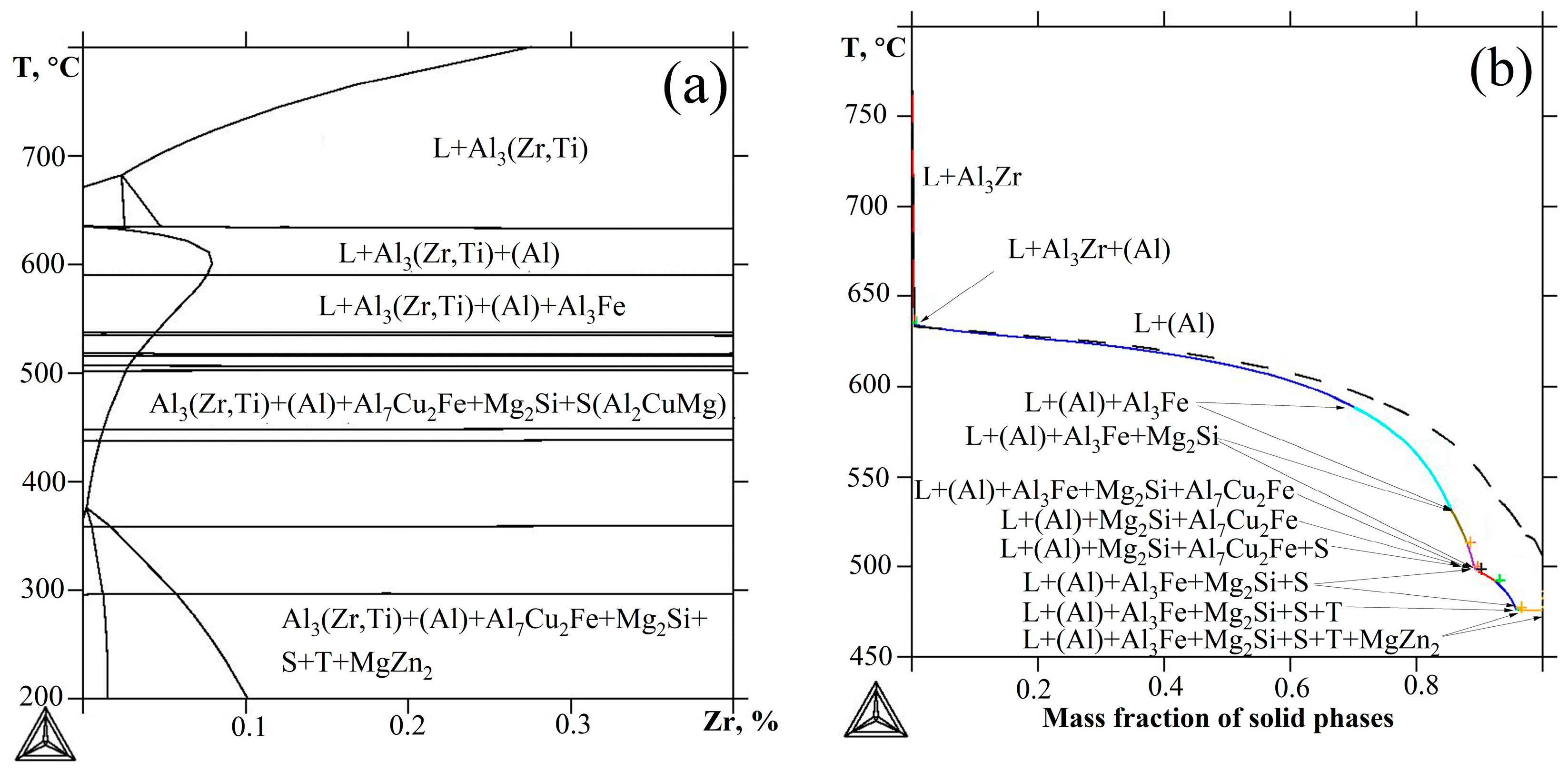

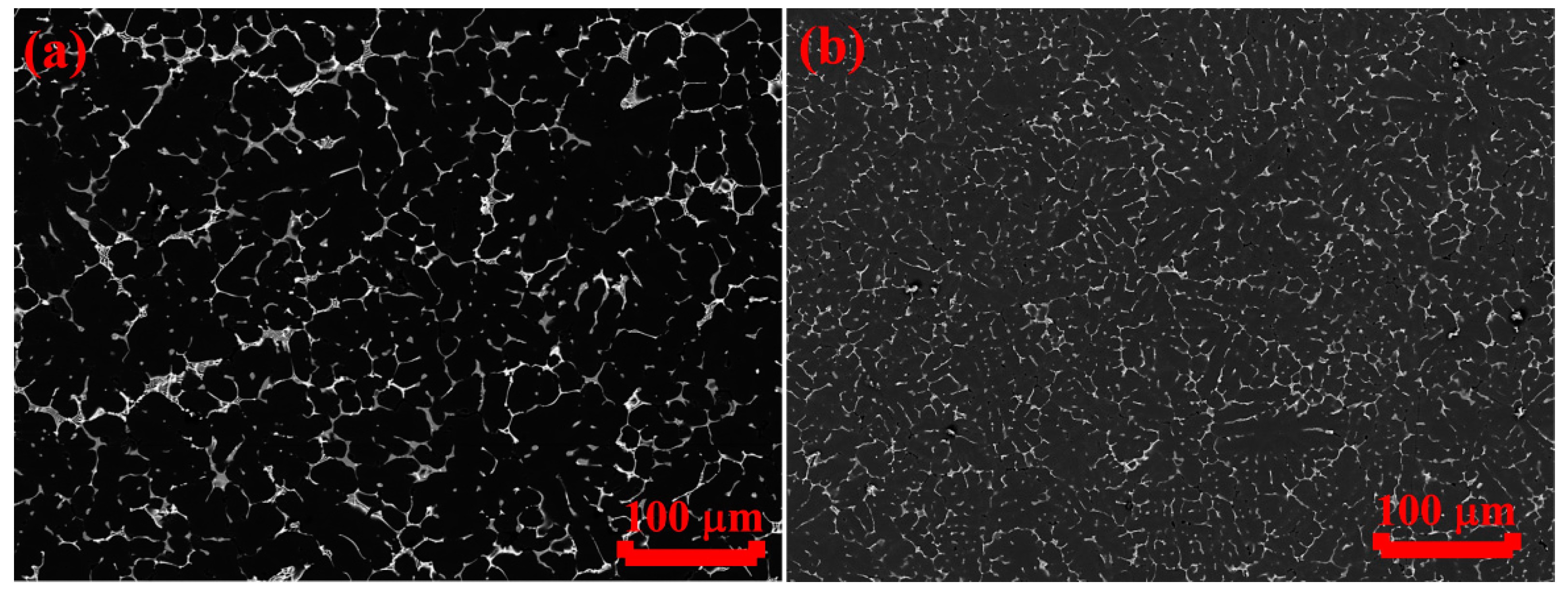
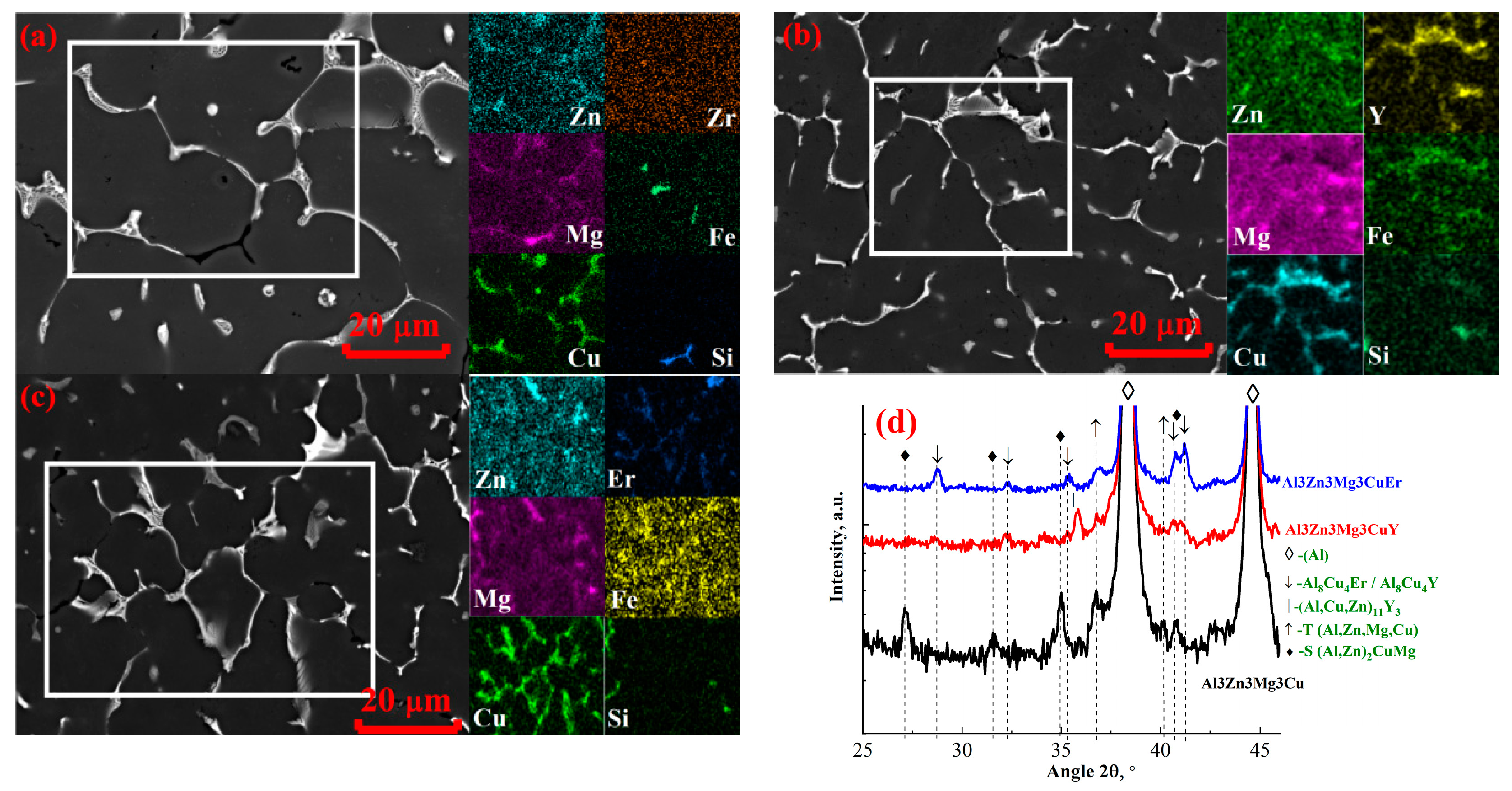

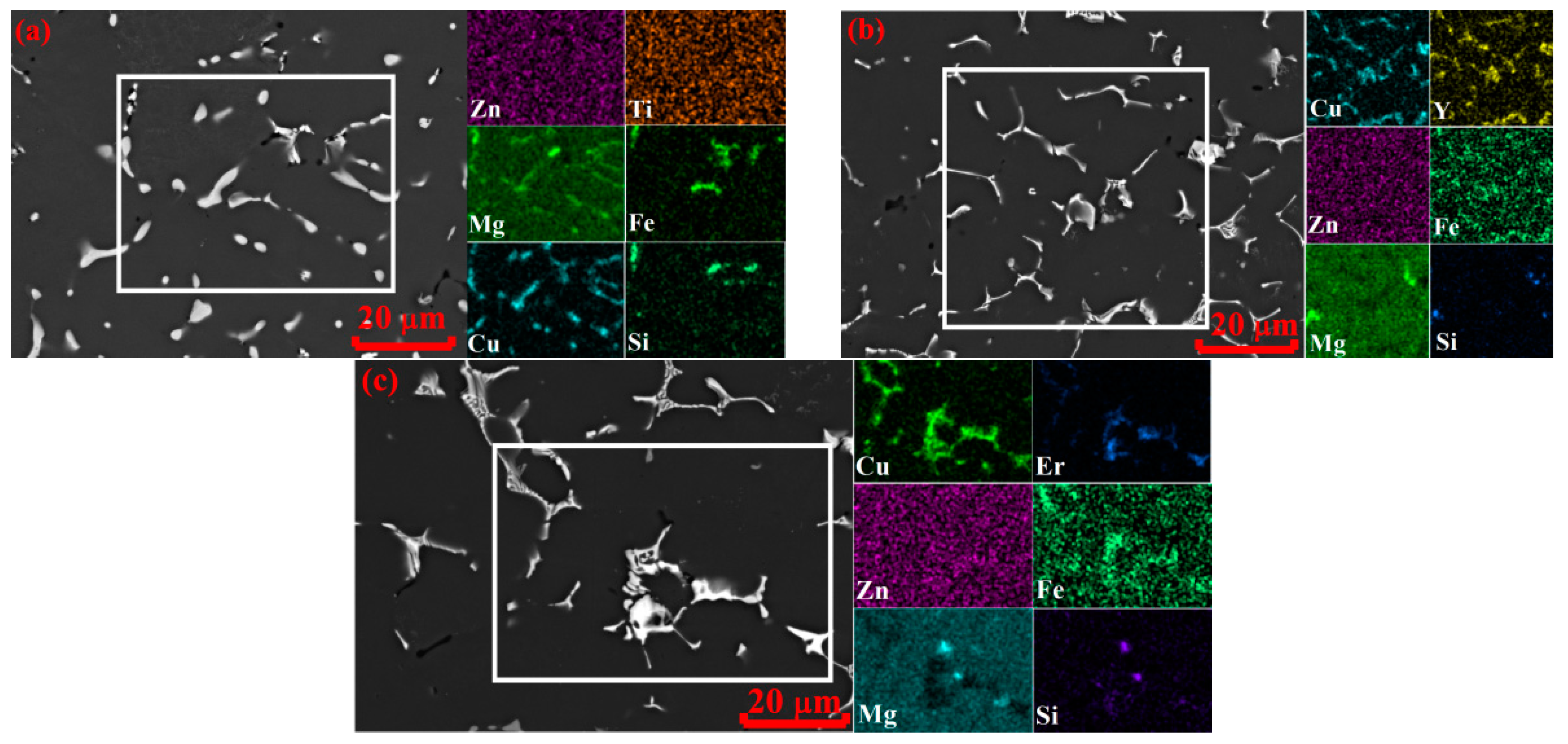

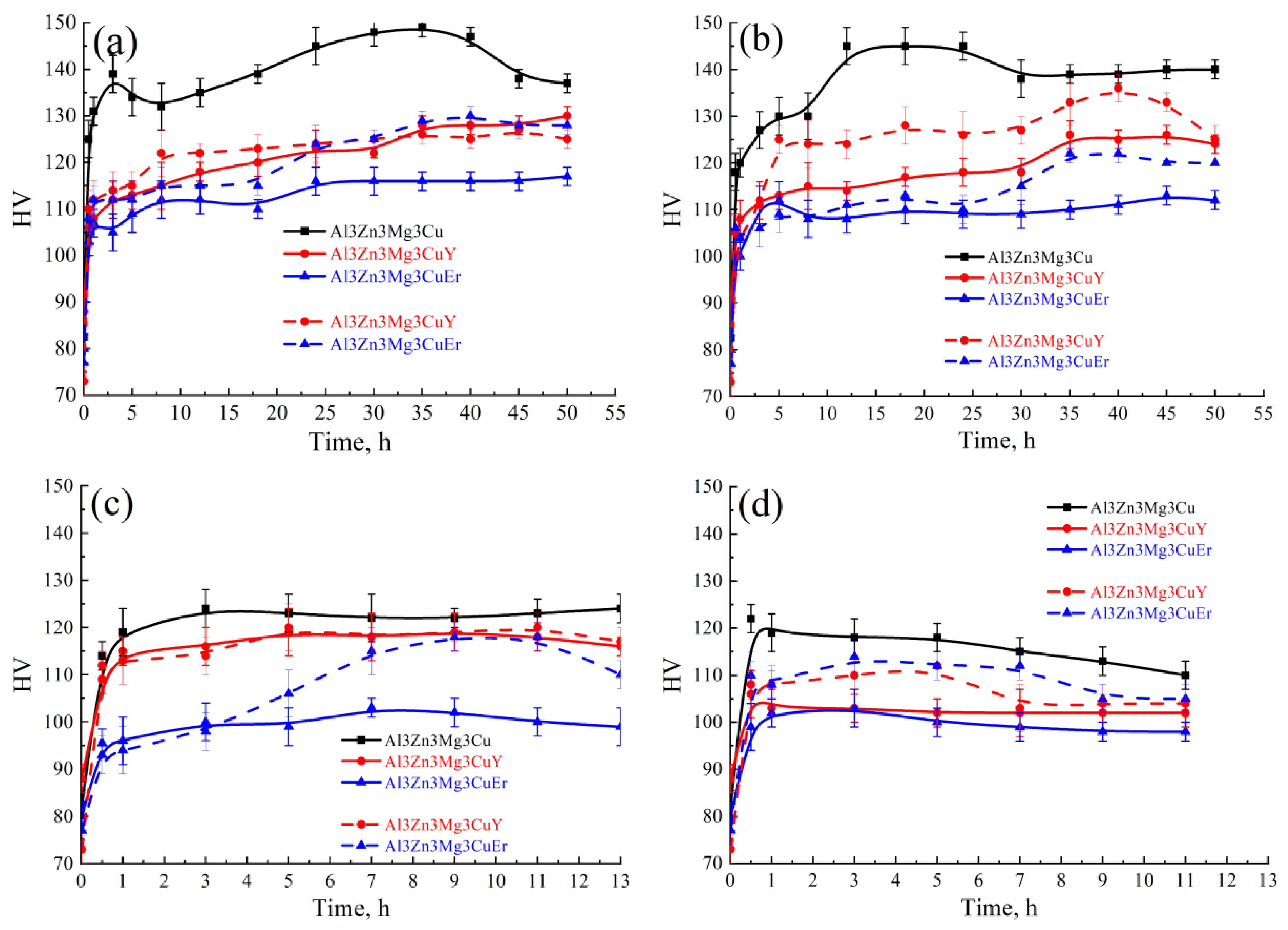
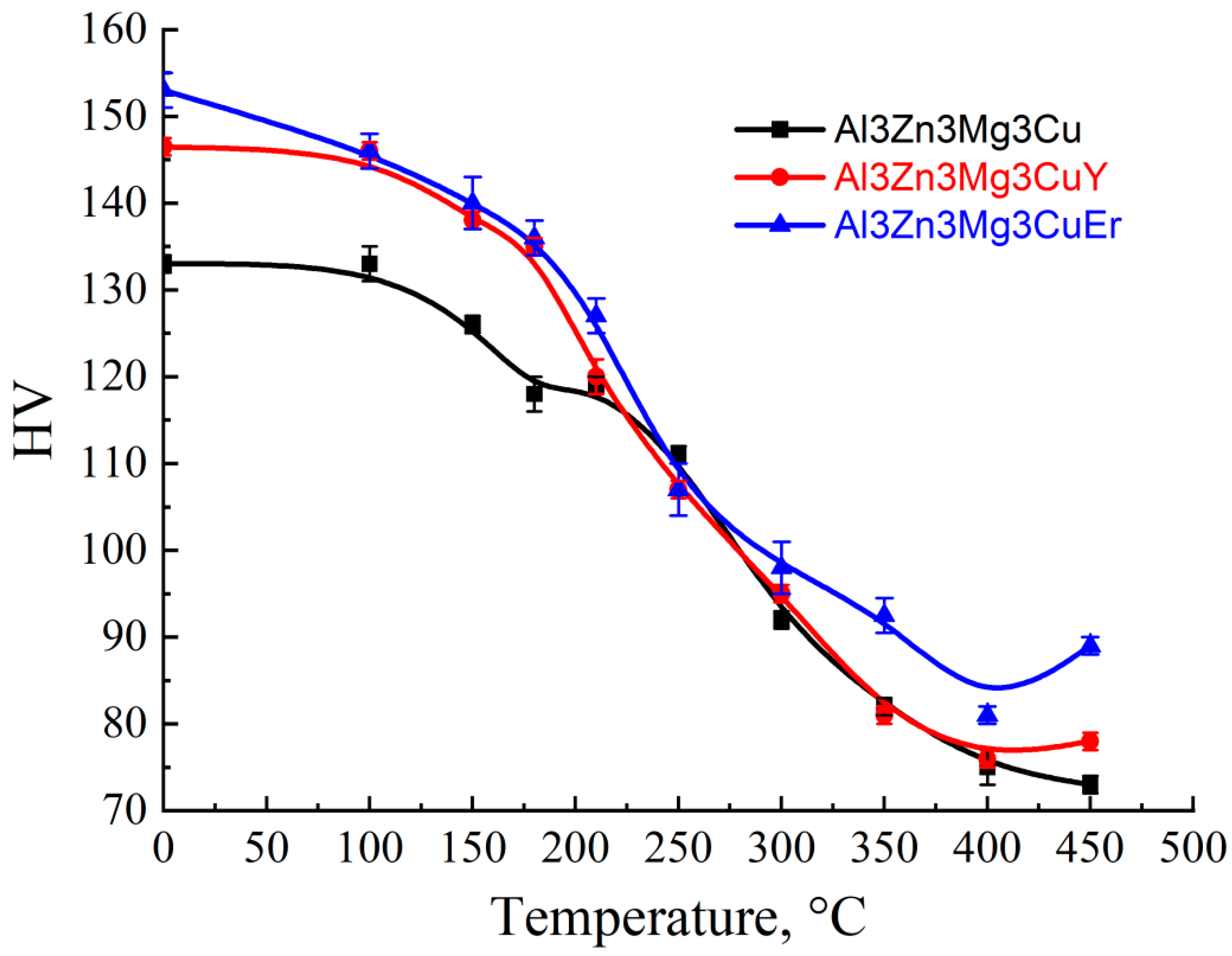
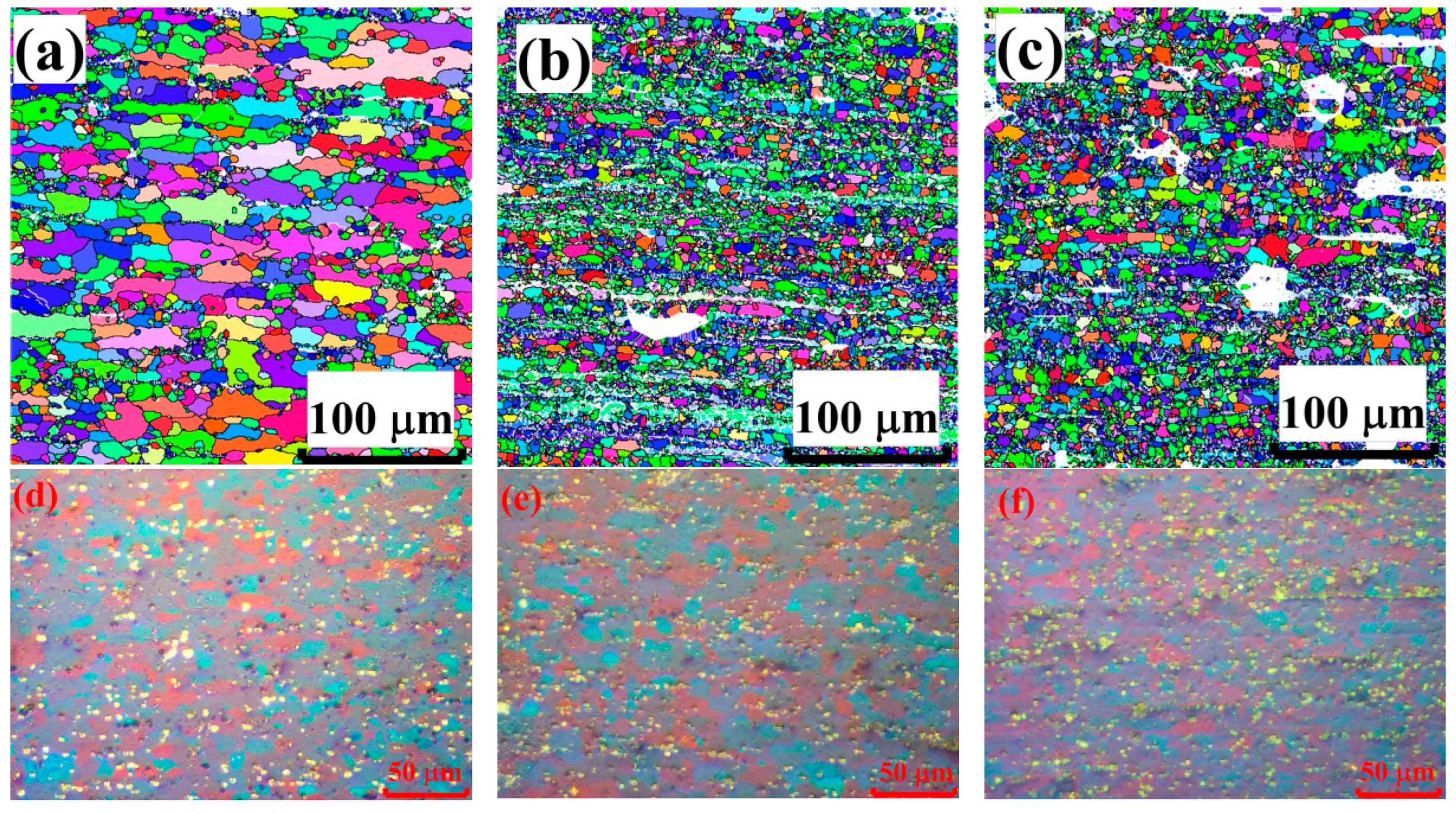
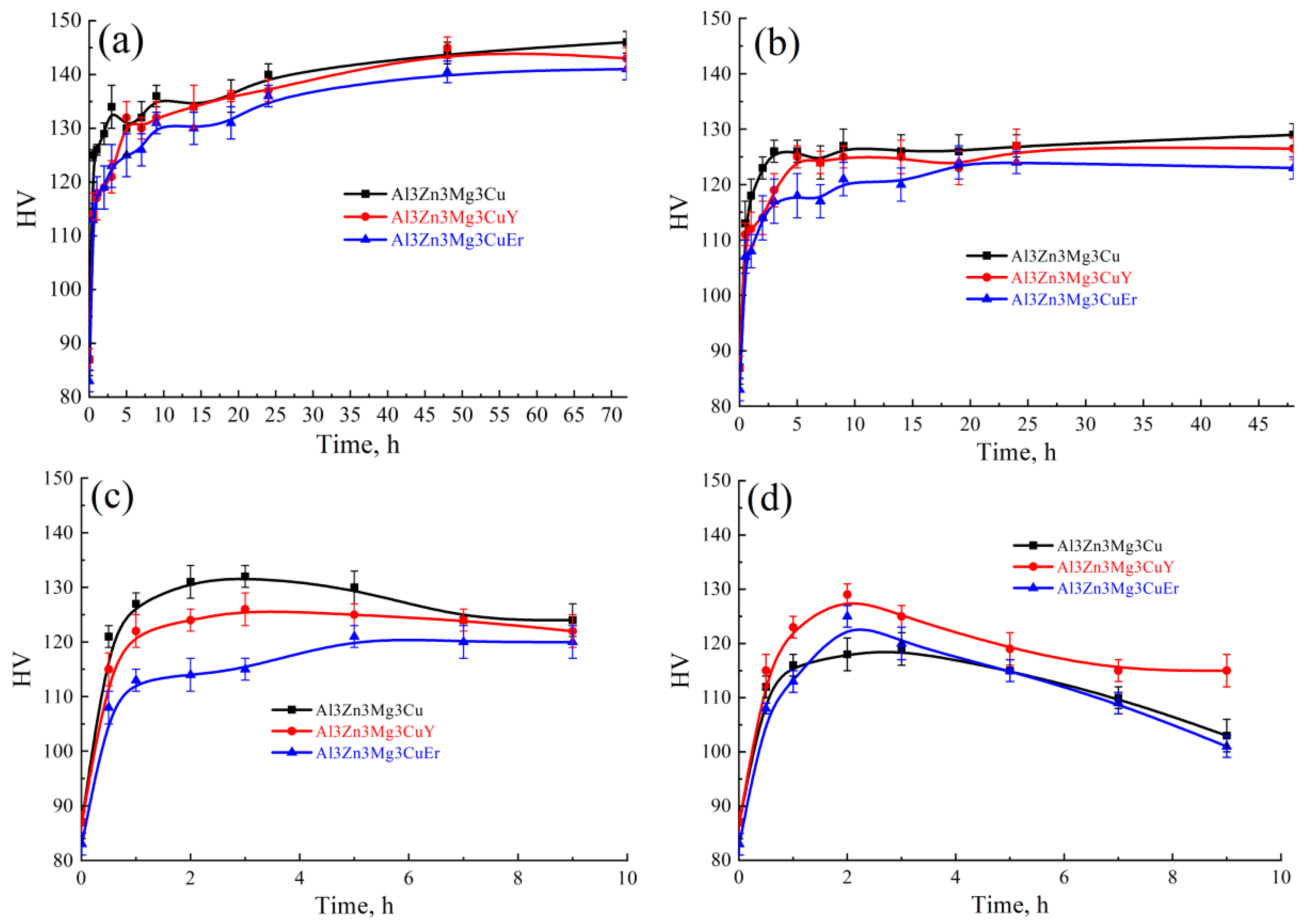
| Alloy | Al | Zn | Mg | Cu | Zr | Ti | Fe and Si | Y or Er |
|---|---|---|---|---|---|---|---|---|
| Al3Zn3Mg3Cu | bal. | 2.8 | 2.7 | 3.0 | 0.2 | 0.1 | 0.3 | - |
| Al3Zn3Mg3CuY | bal. | 3.1 | 2.9 | 2.9 | 0.2 | 0.1 | 0.3 | 0.6 |
| Al3Zn3Mg3CuEr | bal. | 2.9 | 2.8 | 3.0 | 0.2 | 0.1 | 0.3 | 1.4 |
| TL, °C | TS, °C | T65%, °C | TNS, °C | ESR, °C | HCIc, mm |
|---|---|---|---|---|---|
| 761 | 505 | 595 | 475 | 120 | 14 |
| (Al) | S | Al7Cu2Fe | Mg2Si | Al3(ZrTi) |
|---|---|---|---|---|
| bal. (3.1Zn-2.6Mg-2.1Cu) | 1.5 | 1 | 0.37 | 0.4 |
| Alloy | As-Cast State | 480 °C, 3 h | 480 °C, 3 h + 520 °C, 6 h | ||||||
|---|---|---|---|---|---|---|---|---|---|
| Zn | Mg | Cu | Zn | Mg | Cu | Zn | Mg | Cu | |
| Al3Zn3Mg3Cu | 2.7 | 2.0 | 0.6 | 3.2 | 2.5 | 1.6 | - | - | - |
| Al3Zn3Mg3CuY | 2.2 | 2.2 | 1.0 | 3.0 | 3.0 | 1.3 | 3.1 | 3.1 | 1.3 |
| Al3Zn3Mg3CuEr | 2.2 | 1.9 | 1.0 | 3.0 | 3.0 | 1.2 | 3.0 | 3.0 | 1.2 |
| Alloy | YS, MPa | UTS, MPa | El., % |
|---|---|---|---|
| 20 °C | |||
| Al3Zn3Mg3Cu | 290 ± 10 | 340 ± 20 | 1.4 ± 0.4 |
| Al3Zn3Mg3CuY | 280 ± 8 | 340 ± 20 | 3 ± 1 |
| Al3Zn3Mg3CuEr | 270 ± 4 | 330 ± 10 | 2.0 ± 0.5 |
| 200 °C | |||
| Al3Zn3Mg3Cu | 260 ± 8 | 270 ± 6 | 3.0 ± 0.5 |
| Al3Zn3Mg3CuY | 230 ± 6 | 250 ± 5 | 5.2 ± 0.2 |
| Al3Zn3Mg3CuEr | 225 ± 4 | 237 ± 6 | 3.5 ± 0.6 |
| State | YS, MPa | UTS, MPa | El., % |
|---|---|---|---|
| Al3Zn3Mg3Cu | |||
| As rolled | 407 ± 2 | 440 ± 1 | 4.0 ± 0.4 |
| 480 °C for 15 min/120 °C for 48 h | 340 ± 10 | 440 ± 10 | 8.0 ± 1.0 |
| 480 °C for 15 min/150 °C for 32 h | 290 ± 7 | 435 ± 15 | 9 ± 3 |
| 480 °C for 15 min/180 °C for 5 h | 285 ± 5 | 425 ± 5 | 12.5 ± 0.5 |
| 480 °C for 15 min/210 °C for 2 h | 245 ± 10 | 370 ± 5 | 6.8 ± 0.3 |
| Al3Zn3Mg3CuY | |||
| As rolled | 455 ± 8 | 477 ± 3 | 2 ± 1.5 |
| 520 °C for 15 min/120 °C for 48 h | 345 ± 2 | 471 ± 2 | 12.8 ± 1.2 |
| 520 °C for 15 min/150 °C for 32 h | 315 ± 1 | 460 ± 1 | 13.6 ± 0.2 |
| 520 °C for 15 min/180 °C for 5 h | 291 ± 2 | 449 ± 1 | 14.8 ± 1.5 |
| 520 °C for 15 min/210 °C for 2 h | 316 ± 1 | 430 ± 1 | 10.3 ± 1.5 |
| Al3Zn3Mg3CuEr | |||
| As rolled | 450 ± 2 | 474 ± 3 | 3.7 ± 0.5 |
| 520 °C for 15 min/120 °C for 48 h | 334 ± 1 | 446 ± 1 | 14.8 ± 0.1 |
| 520 °C for 15 min/150 °C for 32 h | 300 ± 2 | 434 ± 3 | 12.5 ± 2 |
| 520 °C for 15 min/180 °C for 5 h | 295 ± 13 | 445 ± 5 | 14.8 ± 0.5 |
| 520 °C for 15 min/210 °C for 2 h | 303 ± 1 | 413 ± 1 | 11 ± 2 |
Disclaimer/Publisher’s Note: The statements, opinions and data contained in all publications are solely those of the individual author(s) and contributor(s) and not of MDPI and/or the editor(s). MDPI and/or the editor(s) disclaim responsibility for any injury to people or property resulting from any ideas, methods, instructions or products referred to in the content. |
© 2023 by the authors. Licensee MDPI, Basel, Switzerland. This article is an open access article distributed under the terms and conditions of the Creative Commons Attribution (CC BY) license (https://creativecommons.org/licenses/by/4.0/).
Share and Cite
Glavatskikh, M.V.; Barkov, R.Y.; Gorlov, L.E.; Khomutov, M.G.; Pozdniakov, A.V. Novel Cast and Wrought Al-3Zn-3Mg-3Cu-Zr-Y(Er) Alloys with Improved Heat Resistance. Metals 2023, 13, 909. https://doi.org/10.3390/met13050909
Glavatskikh MV, Barkov RY, Gorlov LE, Khomutov MG, Pozdniakov AV. Novel Cast and Wrought Al-3Zn-3Mg-3Cu-Zr-Y(Er) Alloys with Improved Heat Resistance. Metals. 2023; 13(5):909. https://doi.org/10.3390/met13050909
Chicago/Turabian StyleGlavatskikh, Maria V., Ruslan Yu. Barkov, Leonid E. Gorlov, Maxim G. Khomutov, and Andrey V. Pozdniakov. 2023. "Novel Cast and Wrought Al-3Zn-3Mg-3Cu-Zr-Y(Er) Alloys with Improved Heat Resistance" Metals 13, no. 5: 909. https://doi.org/10.3390/met13050909







